Different Types of Art to Express Who I Am
Due southince prehistoric times, humans have been creating art of various forms. Over the years as tools and technologies have changed and developed, the concept of what art means has come nether scrutiny, and indeed, it is an ongoing debate. In that location are different opinions as to what can exist classified as art. In this commodity, nosotros volition talk over seven of the most widely accepted kinds of fine art without disruptive them with art genre and form in fine art. The seven major forms of art are painting, sculpture, architecture, literature, music, cinema, and theater.
Tabular array of Contents
- ane What Is Art?
- 2 The Seven Forms of Fine art
- ii.1 Painting
- ii.2 Sculpture
- ii.3 Architecture
- ii.iv Literature
- 2.5 Music
- 2.half dozen Movie theatre
- 2.7 Theater
- two.8 Other Fine art Types
- three Frequently Asked Questions
- iii.ane How Do You Define Art?
- 3.2 What Is the Importance of Art?
- three.3 What Are the Seven Different Forms of Art?
- 3.4 What Is Form in Drawing?
What Is Art?
There are about every bit many definitions of art as at that place are people live. As a widely accepted definition, art is produced when imagination or inventiveness are used to create something that can be directly experienced through our senses. Although visual art that is witnessed through our sense of sight is the most common form, fine art tin can appeal to our other senses besides, such as our auditory or tactile perceptions.
Virtually of the art forms that are discussed in this article go dorsum thousands of years. From prehistoric cavern paintings and figurines found in dank caves across the globe to the exquisite compages and sculptures in Greece and Rome, even in the aboriginal world, creativity played a monumental part in personal and public life, as it continues to do today.
Every bit the techniques in fine art have developed, much of the conversation in art circles has been concerned with what the give-and-take "fine art" means.
This cardinal debate is an of import factor in the evolution of personal style within the broad art movements that take emerged over the years, with particular emphasis on the human relationship betwixt utility and aesthetics.
The most dramatic example of fine art that revolutionized the way we call up of it was Marcel Duchamp'sThe Fountain (1917), which explicitly challenged the significant of art by claiming that a slightly modified urinal deserved to exist classified every bit art. This is likewise an epitomic case of how fine art is an important medium through which artists can provide political and social commentary.
 Marcel Duchamp'south Fountain (1917);Marcel Duchamp, Public domain, via Wikimedia Eatables
Marcel Duchamp'south Fountain (1917);Marcel Duchamp, Public domain, via Wikimedia Eatables
Art types should not be dislocated with art genres, which is a different classification organization that was developed past the French Regal Academy and includes even so life, portrait, and history, among others. The differenttypes of art should also be distinguished fromform in art, which refers to a specific element inside an artwork that relates to shape.
Form in art occurs aslope other elements similar texture, colour, space, shape, value, line, and colour.
Art provides u.s. with a crucial glimpse into history – a means through which we can sympathise the life of the humans that came before u.s. and without which the world would be far a far less interesting and inspiring place! It provides a doorway into galaxies of possibility for expression and a platform for political and social commentary.
The Seven Forms of Fine art
Although in that location has been much speculation regarding the definition of art over the years, there is a full general consensus that there are seven main kinds of art, about of which take been around for centuries if not thousands of years. These unlike types of art are painting, sculpture, architecture, literature, music, cinema, and theater.
Painting
Painting is ane of the oldest kinds of art, dating back tens of thousands of years, and is evident on caves at diverse sites across the world, such every bit the Drakensberg in South Africa, the Northern Territory in Australia, and the Lascaux paintings in France to proper name simply three of many sacred sites that are scattered beyond the world. Some of these sites take get designated globe heritage sites to preserve cultural history associated with those areas, and to preserve them.
Painting is the application of paint, usually on a ii-dimensional surface.
Paint consists of a pigment, combined with a binding agent such every bit oil, egg, or h2o and possibly a filler, to make the quantity more substantial. In aboriginal times, people relied on natural materials such as plant affair, basic, and soft stones and rocks to brand their pigments but today artificial coloring is generally used. In modern times, various other additives are included in the ingredients, which brand the paint more convenient and convenient.
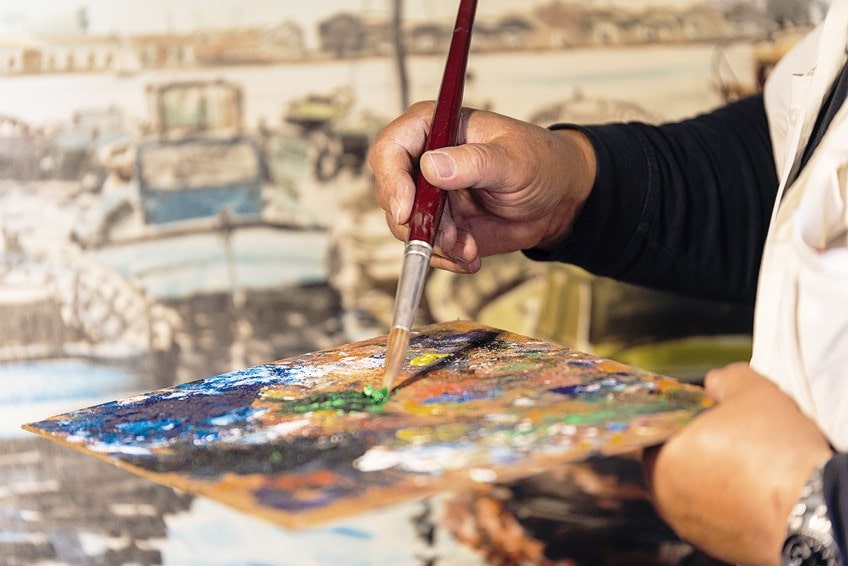
Paint can be applied in diverse means – the sky's the limit. Brushes, fingers, spray cans or sponges can be used, for case. In modern art, painters generally apply canvass to paint on but other surfaces such as board or wood tin can also be used.
As techniques and styles take evolved, painting has become an institution in its own right, inspiring study, analysis, and debate. Paintings tin usually exist classified into one or several of many fine art movements that are characterized in terms of the underlying philosophy that adamant the mode, content, and subject matter of the paintings too as their temporal location in terms of their relationship to previous art movements.
Well-known fine art movements that started in Europe include Impressionism (1867-1886), Surrealism (1924-1966), and Expressionism 1905-1920).
Different cultures all over the globe adult different styles as well, such every bit Popular Art in the Usa in the mid-20th century. There is a countless number of painters who could exist mentioned as examples of artists, but some of the most famous names include Salvador Dalí (1904-1989) from Spain, Jackson Pollock (1912-1956) from the USA, and Katsushika Hokusai (1760-1849) from Nihon.
Sculpture
Sculpture is another ancient art form, dating back to some of the primeval civilizations. Unlike painting though, this form of fine art involves the creation of art in the iii dimensions. The blazon of material used can be anything natural or artificial – from clay, metal, and wood to objects that artists come up across in their everyday lives.
Dissimilar processes tin exist used in creating sculptures, such every bit modeling, casting, assembling, and carving.
Sculptures can exist costless-standing, contained forms, or they can exist made in relief, where the form emerges from a background. An example of a complimentary-standing sculpture is Christ the Redeemer (1931) in Rio de Janeiro by Paul Landowski.
 Christ the Redeemer, Corcovado, Rio de Janeiro, Brazil with Moon background;Donatas Dabravolskas, CC Past-SA 4.0, via Wikimedia Eatables
Christ the Redeemer, Corcovado, Rio de Janeiro, Brazil with Moon background;Donatas Dabravolskas, CC Past-SA 4.0, via Wikimedia Eatables
Mount Rushmore which was constructed between 1927 and 1941 is a colossal demonstration of a sculpture done in relief, equally well equally the elaborate forms carved into the temple circuitous at Khajuraho in India. Sculptures can likewise include other forms of fine art, peculiarly painting.
Figurines and larger examples of sculptures from the aboriginal world have been found in various locations around the earth. They ofttimes had a spiritual or religious connection.
The ancient Greeks and Romans were also known for their exceptional sculptures, such as The Orator andHead of a Roman Patrician, both of which were created in the 1st century BCE. The Statue of Liberty is a more modern example of sculpture (1886) that has become famous effectually the world.
Architecture
People ofttimes identify architecture as going back to the very showtime structures that people congenital as dwellings. If we are to ascertain architecture in this way, we can call up of the teepee in America or the yurt in Mongolia. Some compages has a distinct aesthetic quality though – indeed, the human relationship between utility and beauty is sometimes fundamental in architectural pattern as it is in other forms of art.
Looking back, some of the most exquisite examples of architecture notwithstanding bungle the mind.
Call back of the Pyramids in Egypt which are thousands of years erstwhile, the Colosseum (70 A.D.) in ancient Rome, and the magnificent Taj Mahal (1648) in Republic of india – each of these marvels has its ain story that continues to capture our hearts and remind us of before times in our collective history that reflect the beautiful, middle-wrenching and sometimes darker aspects of what information technology means to be human being.
 The Roman Colosseum; FeaturedPics, CC Past-SA 4.0, via Wikimedia Commons
The Roman Colosseum; FeaturedPics, CC Past-SA 4.0, via Wikimedia Commons
Some of the extraordinary modern-day architectural marvels include the Leaning Tower of Pisa in Italia, the Eiffel Tower (1887) in France, and the Sydney Opera House (1973) in Sydney, Commonwealth of australia. Other gimmicky buildings that accept been dreamt into being that changed the manner we encounter buildings include the Louvre (1793), the Guggenheim Museum (1959), and the Glass House (1949-1995).
Like other kinds of art, architecture also has various styles that accept emerged that reflect sure characteristics or design principles and to which various buildings can exist classified. Some of the nearly well-known include:
- Classical
- Renaissance
- Gothic
- Bizarre
- Neoclassical
- Bauhaus
- Victorian
- Modernistic
- Post-modernistic
Literature
The word "literature" is derived from the Latin word that is translated as "letters" and refers to the written word in particular. Linguistic communication is a powerful and symbolic way of communicating, and writing is no exception. The earliest texts date back thousands of years to Mesopotamia, although it is idea that writing developed independently on different continents.
The kickoff slice of literature with an identifiable writer was some of the prayers written by the priestess Ur in Sumeria in Mesopotamia.
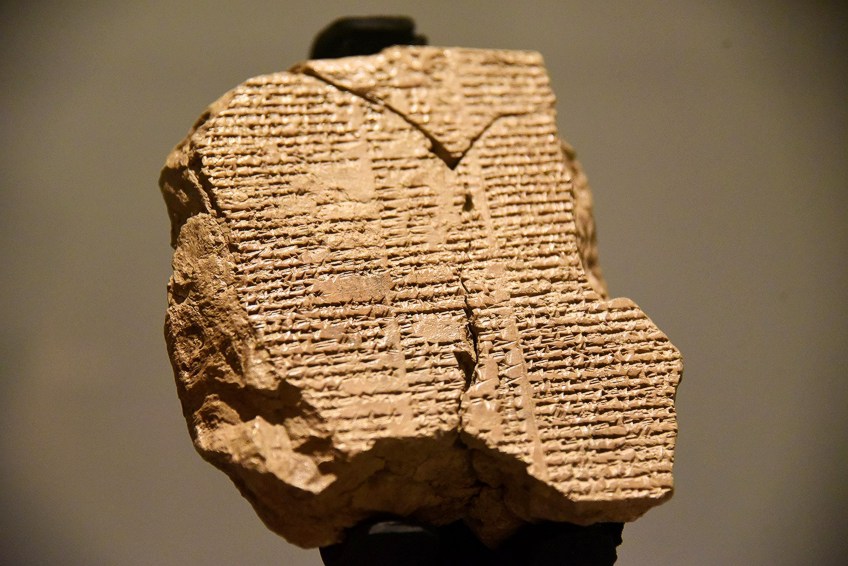 Tablet V of the Ballsy of Gilgamesh, the first recorded piece of literature, dating back to the Old-Babylonian Menstruation, 2003-1595 BCE; Osama Shukir Muhammed Amin FRCP(Glasg), CC BY-SA 4.0, via Wikimedia Commons
Tablet V of the Ballsy of Gilgamesh, the first recorded piece of literature, dating back to the Old-Babylonian Menstruation, 2003-1595 BCE; Osama Shukir Muhammed Amin FRCP(Glasg), CC BY-SA 4.0, via Wikimedia Commons
At different times and in different cultures, societies used the unique technology and resources they institute in their unique, immediate natural environment to write. For example, hieroglyphics were written on rock and papyrus (handmade paper made from plants that grew in h2o). In Sumeria, where evidence of the first author was constitute, the writing that emerged within this culture was done predominantly with wet clay and to communicate across long distances when cities began flourishing and trade became easier.
Words are the medium the author manipulates in creative ways to stimulate an emotional response in readers.

Literature includes verse, articles, novels, plays, sociology, myths, and legends besides every bit other forms of writing. Information technology is about often divided into fiction and non-fiction, but this distinction can sometimes be inappropriate as some stories comprise elements of both, especially in folklore and myth.
The history of literature is teeming with literary giants and their works of art, and information technology is therefore impossible to pinpoint the most influential or the best without resorting to subjective stance. Libraries have kept millions of books around the world since ancient times – today there is a growing industry in electronic text, books, and the storage of information.
Music
Music is created when at that place is an organisation of sounds, as vibrations, that are put together to course an audible composition. Elements of a musical composition include harmony, timbre, tune, and rhythm. Although the presence of music in ancient civilization is harder to trace than visual fine art, remains of musical instruments have been plant that are thousands of years old.
Music and sound created past the vocalism and/or instruments have played an important office in various cultures on all continents of the globe making it a universal characteristic of humanity.
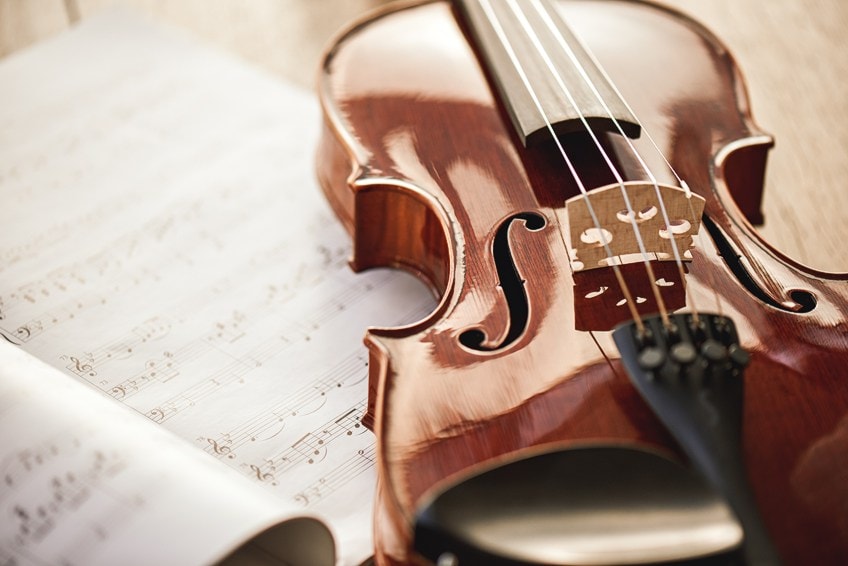
Similar paint, early instruments were made from a variety of natural resources that communities found within their vicinity, while today a vast option of ready-made instruments are available for musicians to choose from that are classified into iii groups: string (such as the violin and guitar), percussion (such as cymbals and the drums) and current of air (such as the flute and saxophone).
While, originally, music was confined to their communities, thanks to modern developments in engineering, today music from different places in the world is becoming more than and more accessible to people in faraway places. In addition to folk music, there is a huge variety of genres in music that includes funk, dejection, hip-hop, popular, rock, electronic, gospel, state, and indie to name a few.
Movie theater
Relative to the other art types discussed in this commodity, cinema is a fairly recent form of art. Instead of attributing the development of cinema to one inventor, many corking minds contributed to the entrance of movie theatre into people'southward lives as is the case with many bang-up inventions and discoveries of our time.
Cinema first took the course of a "kinetoscope" in 1893, which was a contraption that enabled one person to run across the movement picture at a time. The offset public prove was fabricated in 1895 in Paris.
Early films were not as we know them today, and nor was the atmosphere in which they were broadcast. Visuals lasted only a few minutes and some of the content included one-act skits, news, and pictures of lands beyond the borders. Unlike cinema today, at that place was often much participation from the audience.
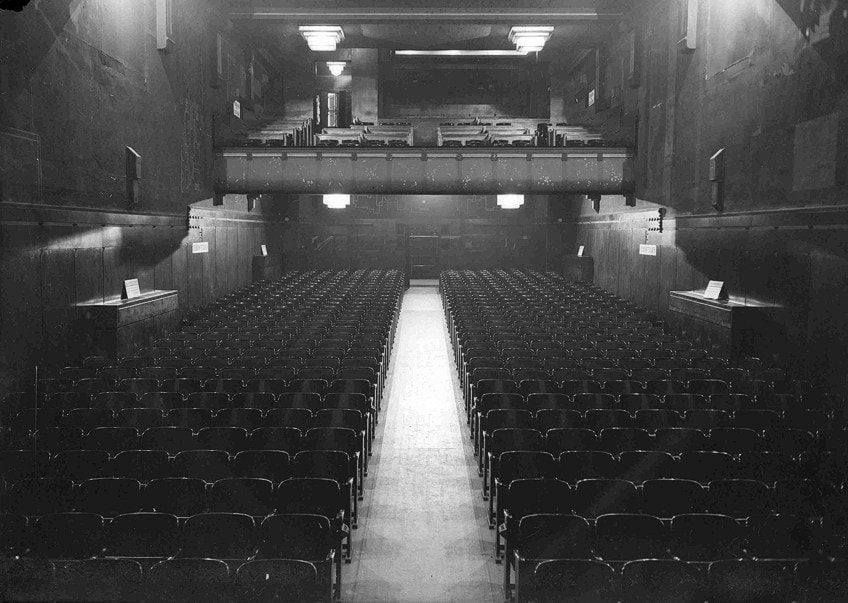 Interior of the Chicago cinema, opened in mid-1912 and destroyed by the bombing of February 22, 1944; Unknown author Unknown author, CC0, via Wikimedia Commons
Interior of the Chicago cinema, opened in mid-1912 and destroyed by the bombing of February 22, 1944; Unknown author Unknown author, CC0, via Wikimedia Commons
The progression of movie theatre into the immensely pop and attainable format we know today occurred inside the space of a picayune over 100 years. Below are the major events that took place that fabricated cinema more attractive to the public:
- 1891: Prototype of kinetoscope by the Edison Company
- 1893: The kinetoscope made its starting time public appearance
- 1895: Public audience by the Lumière brothers using their Cinématographe
- 1909: Colour was introduced
At the turn of the century, much was afoot in the industry of cinema, with many new moving picture industries emerging, especially in Europe and Russia. When they were offset created they did not have sound but by the 1930s, nearly movies had audio.
Since then, the attendance rate has had an exponential increase, with a move in the last few decades toward an increase in film accessibility in individual spaces.
Theater
Theater is a performance art that usually includes a visual element that has been used for amusement purposes for thousands of years. 1 of the most famous locations cardinal to bringing Romans together for amusement was the Colosseum which, although now in ruins, remains a testimony to the flourishing culture of the Roman Empire. Indeed, Rome in the 6th century BCE is seen as the primeval instance of theater in the "western world".
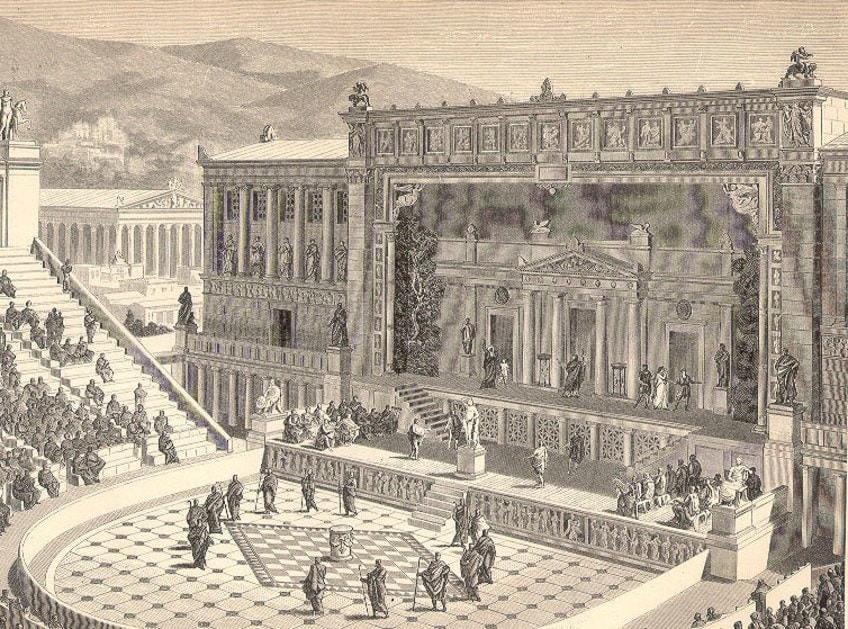 Reconstruction of the theater of Dionysus in Athens during Roman times;From the German 1891 encyclopedia Joseph Kürschner (editor): "Pierers Konversationslexikon". Pierers Konversationslexikon. Siebente Auflage. Mit Universal-Sprachen-Lexikon nach Prof. Joseph Kürschners System. Marriage. (published past) Deutsche Verlagsgesellschaft in Stuttgart, 1891. herausgegeben von (edited by) Joseph Kürschner., Public domain, via Wikimedia Commons
Reconstruction of the theater of Dionysus in Athens during Roman times;From the German 1891 encyclopedia Joseph Kürschner (editor): "Pierers Konversationslexikon". Pierers Konversationslexikon. Siebente Auflage. Mit Universal-Sprachen-Lexikon nach Prof. Joseph Kürschners System. Marriage. (published past) Deutsche Verlagsgesellschaft in Stuttgart, 1891. herausgegeben von (edited by) Joseph Kürschner., Public domain, via Wikimedia Commons
All the same, long earlier this oral storytelling, voice, sounds, and gestures were used to transmit important information from one generation to another before written linguistic communication was invented. Evidence for visual story-telling goes back tens of thousands of years, only it is widely accustomed that story-telling through sounds, song, dance, and charts formed an integral medium through which traditions were passed down and retained.
Theater is a unique grade of fine art in the sense that it tin combine several different forms of art in one theater production. A variety of artists tin be involved in the range of circuitous elements that may be involved in a theater production, including costume and stage designers, musicians, actors, and writers.
Theater tin can accept several forms such as puppetry, dance, circuses, magic shows, or plays.
The history of theater is rich and live with the spectrum of human emotion that we have all experienced when witnessing the stories that are embodied in performance, whether in cinema, theater, or fifty-fifty spoken give-and-take. Genres include tragedy, one-act, and drama.
Although cinema has taken the globe by storm within its relatively short lifespan, theater remains alive and well. Some famous modernistic-day theater productions include Lord of the Dance andThe Lion King which were started in 1996 and 1997 respectively.
 A scene from Disney's theater production of The Panthera leo Male monarch;Barne227, CC Past-SA 4.0, via Wikimedia Commons
A scene from Disney's theater production of The Panthera leo Male monarch;Barne227, CC Past-SA 4.0, via Wikimedia Commons
Other Art Types
In this article, we have explored the seven different types of art that have permeated the boundaries of infinite and time, infiltrated our conceptions of temporality to embody an indelible creative spirit that is the heartbeat of human life.
Afterward expanding upon the 7 primary forms, information technology should exist said that gimmicky art has taken on new faces and forms that should not exist excluded from any mod definition of art, with new artistic horizons being conquered in the realms of fashion, digital fine art, and graphic pattern and photography as three examples of recent trends in art that practice not conform to the types of fine art discussed in this article simply should all the same exist taken into account.
Art has been around since the early days of humanity and has inverse considerably over the centuries. The thread of creativity, expressed in the form of theatre, music, painting, sculpture, architecture, movie theater, and literature, has continued to weave its way across the world and into the cracks of our imagination through the years. Fine art continues to bring colour and life into an ever-irresolute world in a way that not simply stimulates an intellectual response but which besides touches our hearts.
Take a wait at our different types of art webstory here!
Frequently Asked Questions
How Do You Define Art?
Since humans started producing art thousands of years ago, the meaning of the word has become a topic of contend. The common chemical element in all definitions of the word "art" is an element of creativity in the production of something that is accessible to the human senses or experience. Normally, art is visual, such as painting, drawing, or photography only information technology can appeal to other senses as well. Art can combine dimensions of functionality and aesthetics.
What Is the Importance of Art?
Art allows for creative expression and can bring beauty into built environments. Information technology is also a medium through which social and political commentary and criticism can be communicated. Art in all its forms gives us insight into the social and cultural history of humanity and can bring people together in a community that is based on mutual enjoyment and creativity.
What Are the Seven Dissimilar Forms of Art?
In that location are many ways of categorizing dissimilar art forms, most people concord that sculpture, architecture, literature, theatre, cinema, painting, and music are the vii primary art forms, though this excludes other types of art such as photography and digital art.
What Is Class in Drawing?
Concerning the question of what is form in fine art, information technology should exist differentiated from the seven formsof art, namely architecture, literature, sculpture, theater, music, painting, and movie theater. Form in art on the other paw (including cartoon), refers to a depiction of an object that has height, width, and depth – the way an object occupies space whether information technology is in ii dimensions or three. Course is one of several elements in art, among others such as texture, value, color, and shape.
Source: https://artincontext.org/types-of-art/
0 Response to "Different Types of Art to Express Who I Am"
Post a Comment